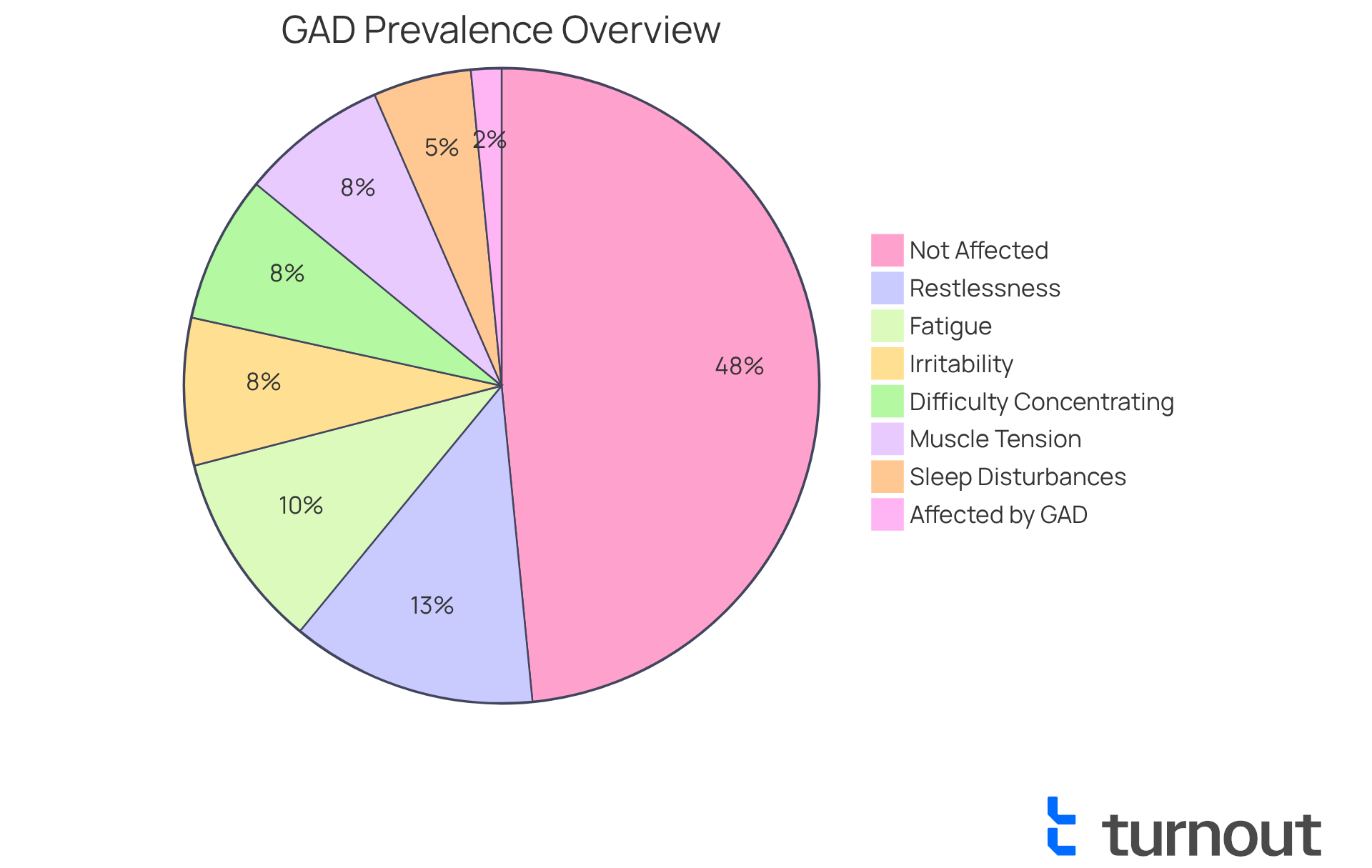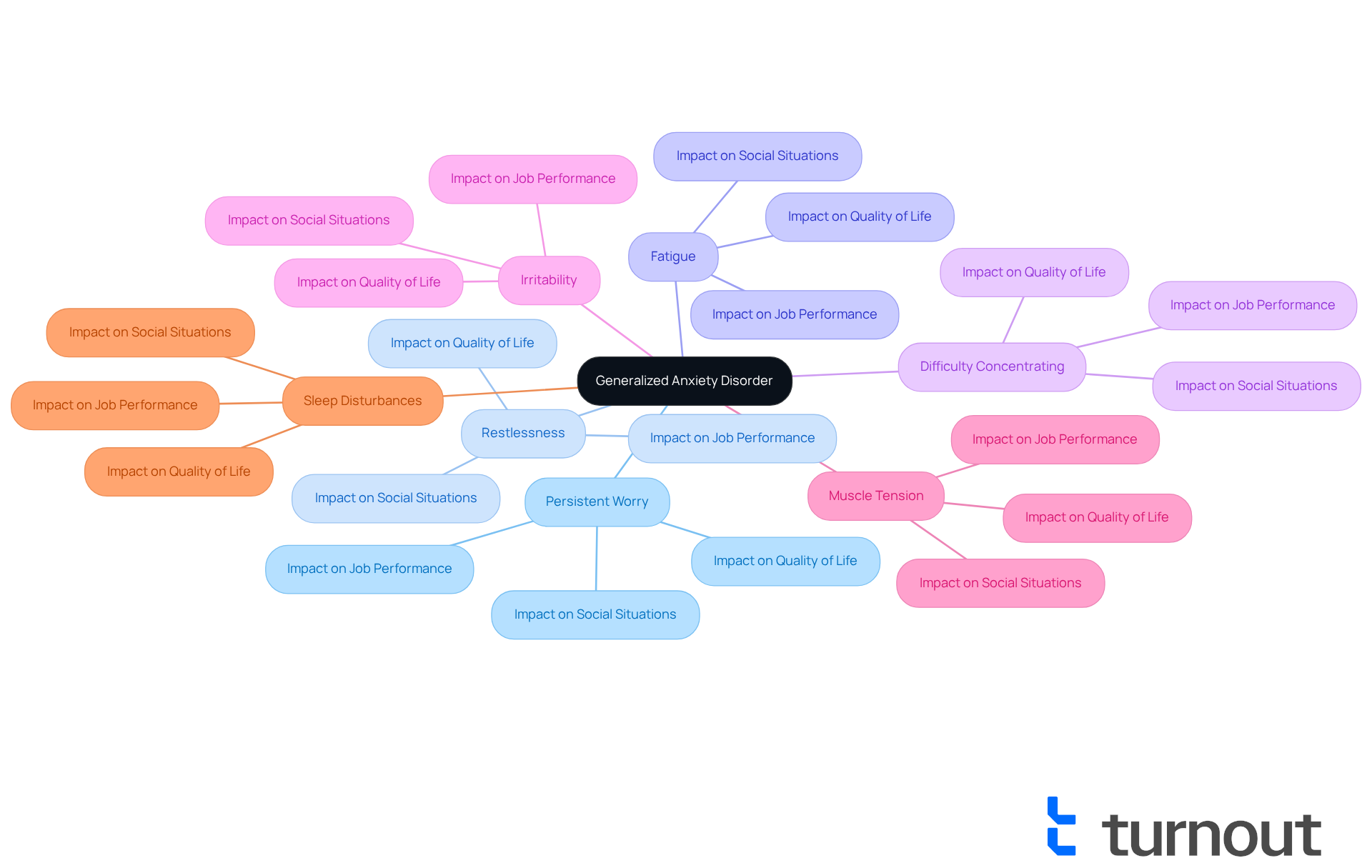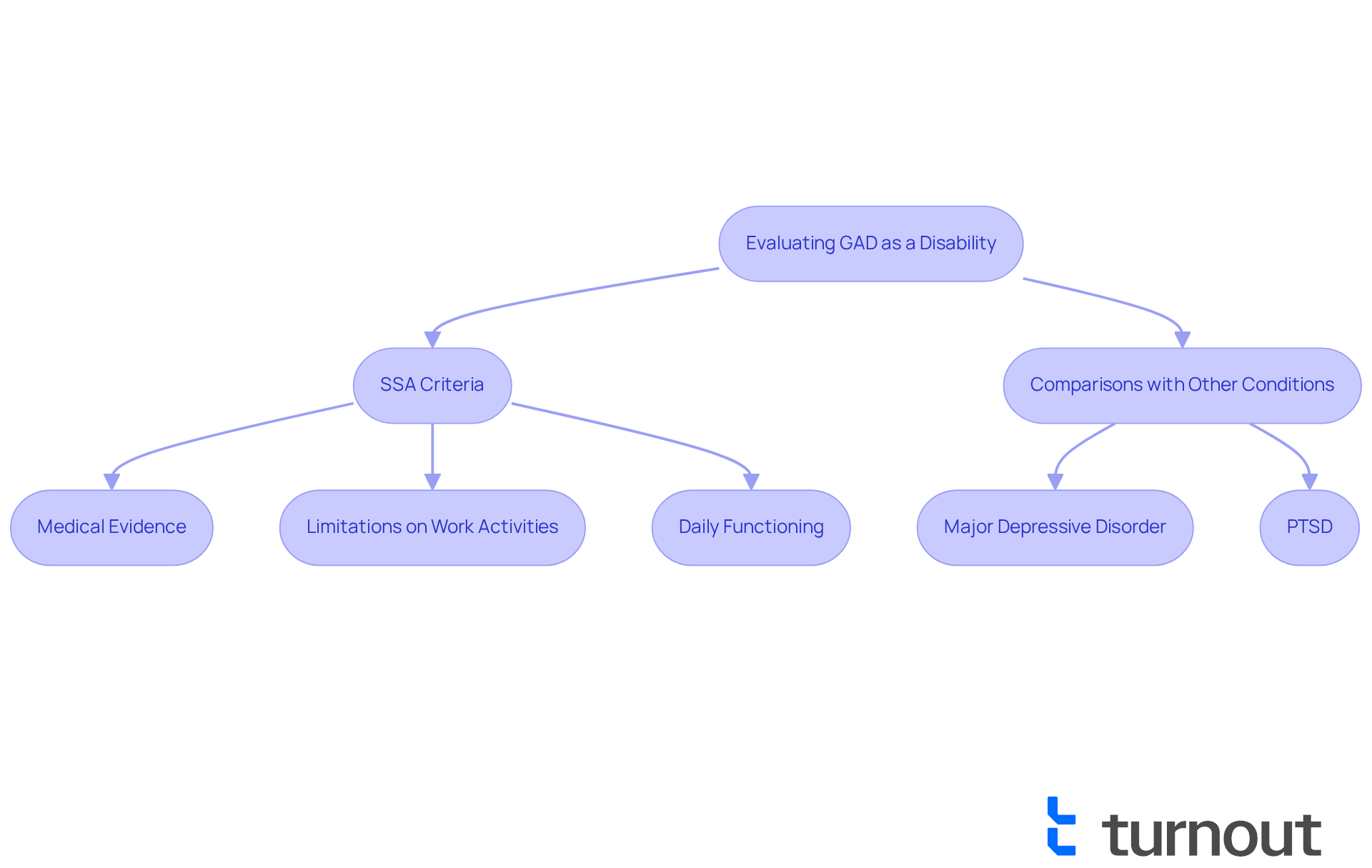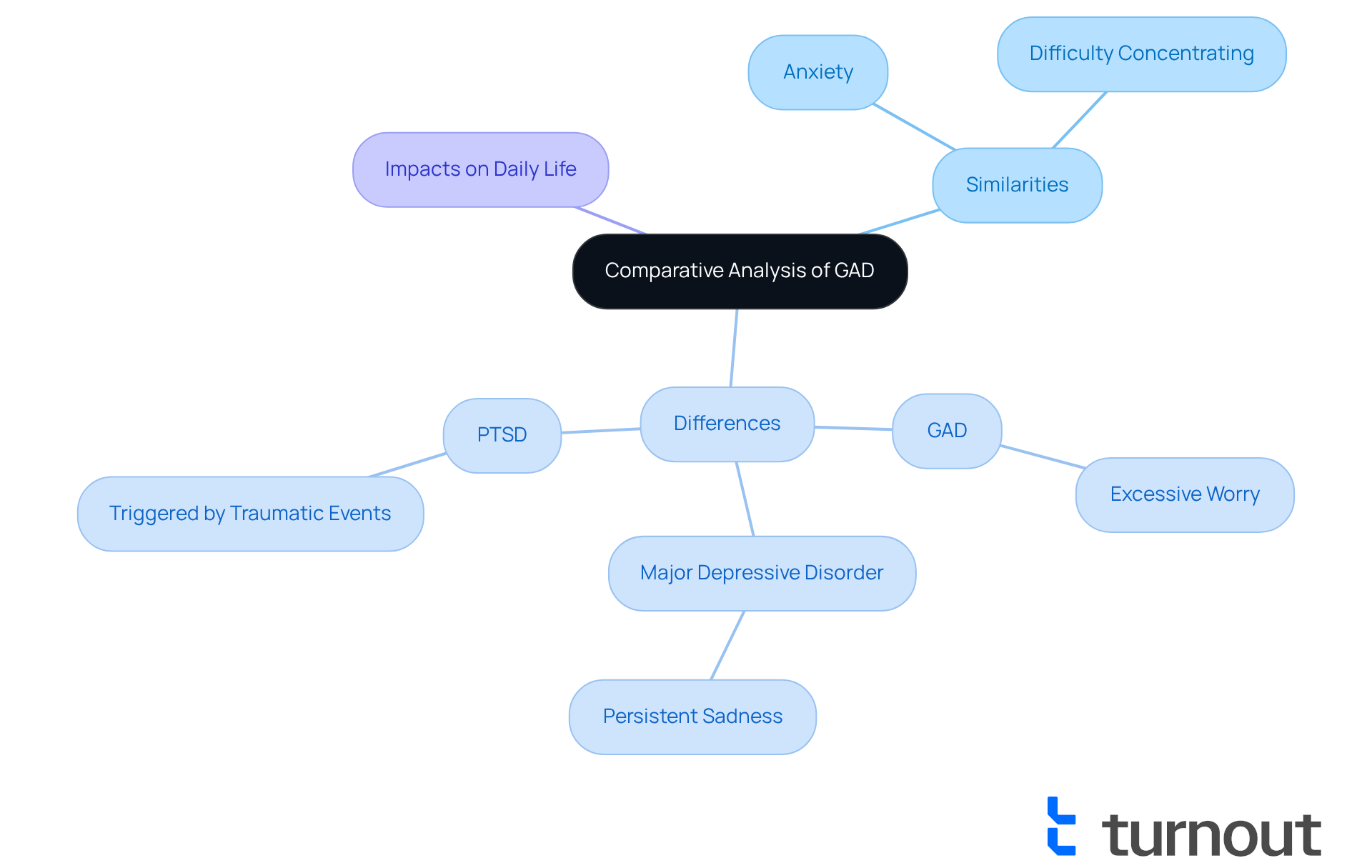Overview
Generalized Anxiety Disorder (GAD) can indeed be viewed as a disability, particularly when it significantly hinders your ability to carry out basic work activities. The Social Security Administration (SSA) has specific criteria that help determine this. We understand that living with GAD can be overwhelming, with symptoms such as persistent worry and difficulty concentrating affecting your daily life.
It's essential to have medical documentation that illustrates how GAD impacts your functioning. This documentation is crucial when applying for disability benefits. Remember, you are not alone in this journey. There are resources and support available to help you navigate this process.
If you find yourself struggling, please reach out for assistance. We're here to help you take the next steps toward finding the support you deserve.
Introduction
Generalized Anxiety Disorder (GAD) affects millions, manifesting as relentless worry alongside a host of debilitating symptoms that can hinder daily life. We understand that living with GAD can feel overwhelming and isolating. As awareness of mental health issues grows, so does the conversation around whether conditions like GAD should be classified as disabilities eligible for support. This raises critical questions about the criteria for disability benefits and how GAD compares to other mental health disorders. Can individuals grappling with GAD find the recognition and assistance they need, or are they left navigating a complex system alone?
It's common to feel uncertain about the support available. Many individuals may wonder if their struggles are valid enough to warrant help. Recognizing GAD as a legitimate concern is a crucial step towards finding the assistance you deserve. We're here to help illuminate the path forward, ensuring that you are not alone in this journey.
Understanding Generalized Anxiety Disorder (GAD)
Generalized Anxiety Disorder (GAD) can be overwhelming. Many individuals experience persistent worries about various aspects of daily life, such as work, health, and social interactions. We understand that it can be challenging to manage these concerns. According to the Diagnostic and Statistical Manual of Mental Disorders (DSM-5), GAD is diagnosed when someone struggles to control their worry more days than not for at least six months.
Symptoms of GAD may include:
- Restlessness
- Fatigue
- Difficulty concentrating
- Irritability
- Muscle tension
- Sleep disturbances
It's important to recognize these signs, as they can significantly impact daily functioning. In fact, GAD affects approximately 3.1% of the U.S. population, with women being twice as likely to receive a diagnosis as men.
Understanding these aspects is crucial. It helps in assessing how GAD influences your daily life and raises the question of whether generalized anxiety disorder is a disability that may qualify you for benefits. Remember, you are not alone in this journey. If you or someone you know is struggling, reaching out for help is a vital step towards managing these feelings. We're here to help you navigate this challenging experience.

Symptoms and Impact of Generalized Anxiety Disorder
People with Generalized Anxiety Disorder (GAD) often face challenges that can significantly disrupt their daily lives. It's common to experience persistent worry, restlessness, fatigue, difficulty concentrating, irritability, muscle tension, and sleep disturbances. These symptoms can make it hard to maintain employment, manage relationships, and complete everyday tasks. For instance, excessive anxiety may lead individuals to avoid social situations or struggle to meet work deadlines, which can ultimately affect job performance and personal connections. The cumulative effect of these challenges can diminish quality of life, raising the question of whether generalized anxiety disorder is a disability that should be recognized in terms of its severity.
At Turnout, we understand the complexities that arise when individuals apply for disability benefits, particularly regarding whether generalized anxiety disorder is a disability. Our compassionate nonlawyer advocates are dedicated to assisting you with Social Security Disability (SSD) claims, ensuring that you receive the support you need without requiring legal representation. Please remember, Turnout is not a law firm and does not provide legal advice. Additionally, we offer guidance for those facing tax debt relief, collaborating with IRS-licensed enrolled agents to help ease financial burdens. Our mission is to empower you to access the benefits you deserve, making the process as straightforward and supportive as possible.

Evaluating GAD as a Disability: Criteria and Comparisons
Navigating the path to disability benefits can be challenging, especially for those questioning if generalized anxiety disorder is a disability. To qualify, specific criteria set by the Social Security Administration (SSA) must be met. It's crucial to provide medical evidence that documents your GAD diagnosis and shows how it significantly limits your ability to perform basic work activities. This means demonstrating how GAD disrupts your daily functioning, such as maintaining a job or managing personal care.
You might find it comforting to know that other mental health conditions, like major depressive disorder or post-traumatic stress disorder (PTSD), are evaluated using similar criteria. The focus remains on the severity of symptoms and their impact on your daily life. Understanding the question of whether generalized anxiety disorder is a disability is essential for anyone looking to determine eligibility for disability benefits based on GAD.
At Turnout, we offer tools and services designed to help you navigate these complex processes. Our goal is to ensure you receive the necessary support without the burden of legal representation. It’s important to note that Turnout is not a law firm and does not provide legal advice. Instead, we utilize trained nonlawyer advocates who are here to guide you through your SSD claims.
Remember, you are not alone in this journey. We’re here to help you every step of the way.

Comparative Analysis: GAD and Other Mental Health Conditions
When comparing Generalized Anxiety Disorder (GAD) to other mental health conditions, we recognize that several similarities and differences emerge. For instance, both GAD and major depressive disorder can lead to significant challenges in daily life. However, their manifestations differ. GAD is characterized by excessive worry and anxiety, while major depressive disorder often involves persistent sadness and a loss of interest in activities.
It's also important to note that PTSD shares overlapping symptoms with GAD, such as anxiety and difficulty concentrating. Yet, PTSD is specifically triggered by traumatic events. Understanding these distinctions is crucial for evaluating the severity of each condition and determining if generalized anxiety disorder is a disability for eligibility for disability benefits. Each disorder's unique characteristics and impacts on daily life play a significant role in the assessment process.
We understand that navigating these conditions can feel overwhelming, but you're not alone in this journey. If you or someone you know is struggling, seeking support can be a vital step toward healing.

Conclusion
Generalized Anxiety Disorder (GAD) profoundly affects individuals, often leading to persistent worries and significant disruptions in daily life. Understanding whether GAD qualifies as a disability is essential for those seeking support and benefits. The impact of this disorder can hinder one's ability to function effectively in various aspects of life, including work and personal relationships.
We understand that the symptoms of GAD, such as restlessness, fatigue, and difficulty concentrating, can severely limit daily activities and overall quality of life. It's crucial to meet specific criteria set by the Social Security Administration to determine eligibility for disability benefits. By comparing GAD with other mental health conditions, like major depressive disorder and PTSD, we can underscore the unique challenges posed by GAD while also acknowledging the similarities in their impacts.
Recognizing the significance of GAD as a potential disability opens the door for individuals to seek the support they deserve. It is vital for those affected to understand their rights and the resources available to them, including assistance from advocates who can guide them through the complexities of the disability benefits process.
By raising awareness and encouraging open discussions about mental health, we can foster a more supportive environment for individuals navigating the challenges of Generalized Anxiety Disorder. Remember, you are not alone in this journey, and we're here to help you find the support you need.
Frequently Asked Questions
What is Generalized Anxiety Disorder (GAD)?
Generalized Anxiety Disorder (GAD) is a mental health condition characterized by persistent worries about various aspects of daily life, including work, health, and social interactions.
How is GAD diagnosed?
GAD is diagnosed when an individual struggles to control their worry more days than not for at least six months, according to the Diagnostic and Statistical Manual of Mental Disorders (DSM-5).
What are the common symptoms of GAD?
Common symptoms of GAD include restlessness, fatigue, difficulty concentrating, irritability, muscle tension, and sleep disturbances.
How prevalent is GAD in the U.S. population?
GAD affects approximately 3.1% of the U.S. population, with women being twice as likely to receive a diagnosis compared to men.
Can GAD impact daily functioning?
Yes, the symptoms of GAD can significantly impact daily functioning, making it important to recognize and address these signs.
Is GAD considered a disability?
Understanding how GAD influences daily life raises the question of whether it may qualify as a disability for benefits, depending on individual circumstances.
What should someone do if they are struggling with GAD?
If you or someone you know is struggling with GAD, reaching out for help is a vital step towards managing these feelings.




